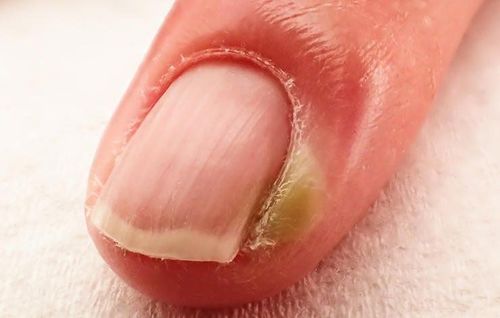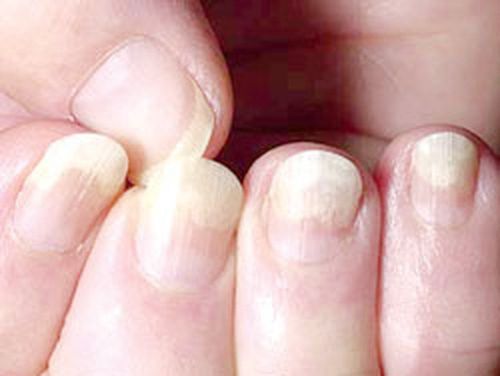This is an automatically translated article.
Subungual angioma is a rare benign tumor characterized by cold intolerance, severe paroxysmal pain, and well-defined localization of pain. However, the definitive diagnosis is made only by histology after surgical resection.1. What is U coil under the nail?
Corolla tumor was first described by Wood in 1812 and later named by Masson in 1924. This is an uncommon, benign lesion originating from structures called coils in the muscles. organs, essentially neuromuscular structures involved in local temperature regulation and blood flow regulation.Choroid tumors are found in the dermis, this lesion tends to be more concentrated in the hands and feet, up to 80% of choriomas are found in the arms, especially many under the nail hand should be called subungual vascular tumor.
Subungual vascular tumor usually affects a group of middle-aged patients, typical clinical symptoms are severe paroxysmal pain with obvious pain points, sensitive to cold. Although these symptoms are highly suggestive of a coiled tumor, the diagnosis is often delayed because it must be based on histological confirmation after resection.
2. Clinical signs and symptoms of subungual angioma
Clinically, subungual angiomas present as visible or palpable masses, pinkish red or bluish spots, increasing curvature as well as causing nail deformity. Occasionally, nail dystrophy may be the only sign of subungual angioma.In addition, the classic triad of subungual angioma is paroxysmal pain, sensitivity to cold, and obvious pain location. However, not all symptoms are consistent and will vary from person to person, although pain remains the most common sign.

U cuộn mạch dưới móng là một khối u lành tính hiếm gặp ở móng
3. How to diagnose subungual cystic tumor?
Patient history and physical examination are key to diagnosing subungual angioma. However, the diagnosis can sometimes be difficult, especially in the early stages when the subungual lesion is very small and the clinical signs are still incomplete.It is this that explains the delay in the diagnosis of lesions (sometimes up to 15 years). On the other hand, the presence of pain in most cases sometimes warrants the differential diagnosis from painful tumors that may occur in the extremities, such as neuroma, gouty arthritis or calcification. At this point, the diagnosis can be confirmed based on histological examination.
Clinical Examination Love's Manipulation: This test is directional by probing with a needle or sharp instrument causing pain in the affected area, but not the area adjacent to it. The Love maneuver has a sensitivity of 100% but a specificity of 0%.
Hildreth's sign: Hildreth's sign refers to the occurrence of pain after
ischemic onset by applying tourniquets to the arm. This highlights the vascular nature of the lesion with a sensitivity of 77.4% to 92% and a specificity of 91% to 100%.
Cold sensitivity test: Applying cold water or ethanol to the affected area will also trigger symptoms. This test has a sensitivity and specificity of 100%.
Penetration test: Penetration test is performed in the dark by passing light through a finger pad. The red, opaque image observed in the area of the tumor allows size estimation with a sensitivity of 23% to 38% and a specificity of 90%.
Imaging Even when a lesion is diagnosed based on symptoms and physical examination, imaging tools are important to determine the location of the tumor and determine its size before surgery removed to avoid recurrence.
X-ray, ultrasound, and magnetic resonance imaging have been used for preoperative diagnosis, while other imaging techniques such as angiography, scintigraphy, and thermography failed to show lesions.
Pathology Isolated subungual angiomas usually present as small reddish-gray sheaths 0.1 to 0.3 cm in diameter. The structure of vascular tumors is usually made up of 3 components, i.e. coiled cells, vascular structures and smooth muscle cells. Thus, according to the major part of the composition, subungual angiomas can be classified as solid angiomas (less vascular structure), angiomas (with a prominent vascular component), or myomas (with a prominent vascular component). glomangiomyomas with predominance of vascular and smooth muscle structures).
The presence of a small amount of nerve fibers in the lesion indicates a subungual angioma with subtle tenderness. Immunohistochemistry for these tumors involves staining with antibodies to actin and vimentin. Glomus cell neoplasms stain positive for CD34 and actin smooth muscle.

U cuộn mạch dưới móng có triệu chứng điển hình là không chịu được lạnh
4. How to treat subungual angioma?
The treatment of subungual angioma is usually complete surgical excision, which can cure the disease. Recovery usually takes 2 to 4 weeks, but the pain sometimes lasts longer.The rate of recurrence after surgery is reported to be in the range of 5% to 15%. In particular, the pain may return after a few weeks but take many years to appear again. When recurrence occurs early, this is usually due to incomplete tumor resection, while delayed recurrence tends to be due to the presence of a second tumor.
Another complication of subungual angioma surgery is nail dystrophy, which occurs in the event of damage to the foundation. However, nail dystrophy can also occur when the tumor is adherent or due to surface irregularities in the nail bed after surgery.
In patients who do not want surgery or if surgery is not possible, there are some reports that indomethacin can control pain for 10 days. Besides, the use of pulsed dye laser, argon laser, CO2 laser and sclerotherapy have also shown positive results.
In summary, subungual angioma is a rare benign tumor, usually diagnosed after the patient has suffered from localized severe pain. Clinical signs and physical examination are the cornerstones of diagnosis, but new imaging guides the intervention and histological findings are definitive. Surgery is the most common treatment, but it needs to be handled with caution, taking the entire lesion to avoid the possibility of recurrence.
Please dial HOTLINE for more information or register for an appointment HERE. Download MyVinmec app to make appointments faster and to manage your bookings easily.










